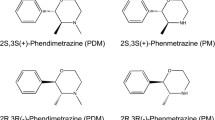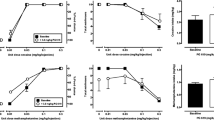Abstract
Sibutramine hydrochloride, a novel monoamine reuptake inhibitor antidepressant, has been studied to determine whether it alters dopaminergic function in the brain. Its effects have been compared with bupropion, a dopamine reuptake inhibitor, and methamphetamine, a dopamine reuptake inhibitor and releasing agent. Sibutramine (0.1–3 mg/kg PO) and methamphetamine (0.3–30 mg/kg PO) both prevented reserpine (0.75 mg/kg IV) ptosis in rats with ED50 values of 0.6 mg/kg and 4.2 mg/kg, respectively. Bupropion (10–100 mg/kg PO) was ineffective against reserpine ptosis. The efflux of [3H]-dopamine from preloaded rat striatal slices was not altered by 10−7–10−5 M concentrations of sibutramine, BTS 54 354, BTS 54 505 (secondary and primary amine metabolites, respectively) or bupropion. In contrast, methamphetamine (10−8–10−4 M) caused a significant concentration-dependent increase in [3H]-dopamine release. Sibutramine (3 mg/kg IP or 6 mg/kg PO) and bupropion (10 mg/kg IP or 430 mg/kg PO) did not alter 3-methoxy-tyramine (3-MT) levels in rat striatum. Striatal 3-MT concentrations were, however, dose-dependently increased by methamphetamine (0.3–10 mg/kg IP or 0.42–4.2 mg/kg PO). Sibutramine (6 mg/kg PO) did not induce circling in rats with unilateral 6-hydroxydopamine lesions of the nigrostriatal dopaminergic neuronal tract. Bupropion (10–100 mg/kg PO) did not induce circling at the lowest dose, but caused increasing ipsilateral rotation at higher doses. Methamphetamine (0.42 or 4.2 mg/kg PO) induced ipsilateral circling with marked effects at the higher dose. In a two-choice lever pressing model using rats trained to discriminated-amphetamine (0.5 mg/kg IP) from saline, sibutramine (0.3–3 mg/kg IP) generalised to the saline lever. Bupropion (3–30 mg/kg IP) generalised tod-amphetamine at the highest dose, while methamphetamine (0.1–5 mg/kg IP) generalised to this lever at doses as low as 0.3 mg/kg. Overall, the rank order of potency for enhancing central dopaminergic function is methamphetamine > bupropion >> sibutramine. The data therefore indicate that dopamine is unlikely to be an important pharmacological target for reuptake inhibition by sibutramine.
Similar content being viewed by others
References
Blitzer RD, Becker RE (1985) Characterization of the bupropion cue in the rat: lack of evidence for a dopaminergic mechanism. Psychopharmacology 85:173–177
Braestrup C (1977) Biochemical differentiation of amphetamine vs methylphenidate and nomifensine in rats. J Pharm Pharmacol 29:463–470
Buckett WR, Thomas PC, Luscombe GP (1988) The pharmacology of sibutramine hydrochloride (BTS 54 524), a new antidepressant which induces rapid noradrenergic down-regulation. Prog Neuropsychopharmacol Biol Psychiatry 12:575–584
Cheetham SC, Viggers JA, Slater NA, Buckett WR (1990) Inhibition of [3H]paroxetine binding by sibutramine, its metabolites and other antidepressants correlates with inhibition of [3H]5-hydroxytryptamine uptake. Br J Pharmacol 101:515P
Cooper BR, Hester TJ, Maxwell RA (1980) Behavioral and biochemical effects of the antidepressant bupropion (Wellbutrin): evidence for selective blockade of dopamine uptake in vivo. J Pharmacol Exp Ther 215:127–134
Di Giulio AM, Groppetti A, Cattabeni F, Galli CL, Maggi A, Algeri S, Ponzio F (1978) Significance of dopamine metabolites in the evaluation of drugs acting on dopaminergic neurons. Eur J Pharmacol 52:201–207
Fuller RW, Perry KW, Bymaster FP, Wong DT (1978) Comparative effects of pemoline, amfonelic acid and amphetamine on dopamine uptake and release in vitro and on brain 3,4-dihydroxyphenylacetic acid concentration in spiperone-treated rats. J Pharm Pharmacol 30:197–199
Heal DJ, Butler SA, Hurst EM, Buckett WR (1989) Antidepressant treatments, including sibutramine hydrochloride and electro-convulsive shock, decreaseβ 1-but notβ 2-adrenoceptors in rat cortex. J Neurochem 53:1019–1025
Heal DJ, Frankland ATJ, Buckett WR (1990) A new and highly sensitive method for measuring 3-methoxytyramine using HPLC with electrochemical detection. Studies with drugs which alter dopamine metabolism in the brain. Neuropharmacology 29:1141–1150
Heal DJ, Prow MR, Buckett WR (1991) Effects of antidepressant drugs and electroconvulsive shock on pre- and postsynapticα 2-adrenoceptor function in the brain: rapid down-regulation by sibutramine hydrochloride. Psychopharmacology 103:251–257
Jones CN, Howard JL, McBennett ST (1980) Stimulus properties of antidepressants in the rat. Psychopharmacology 67:111–118
Kerwin RW, Pycock CJ (1979) Specific stimulating effect of glycine on [3H]-dopamine efflux from substantia nigra slices of the rat. Eur J Pharmacol 54:93–98
Luscombe GP, Hopcroft RH, Thomas PC, Buckett WR (1989) The contribution of metabolites to the rapid and potent down-regulation of rat corticalβ-adrenoceptors by the putative antidepressant sibutramine hydrochloride. Neuropharmacology 28:129–134
Luscombe GP, Slater NA, Lyons MB, Wynne RD, Scheinbaum ML, Buckett WR (1990) Effect on radiolabelled-monoamine uptake in vitro of plasma taken from healthy volunteers administered the antidepressant sibutramine HCl. Psychopharmacology 100:345–349
Martin KF, Phillips I, Cheetham SC, Heal DJ, Buckett WR (1990) Only antidepressants with marked effects on central dopamine function decrease rat striatal D2 receptor number. Br J Pharmacol 100:405P
Nielsen JA, Shannon NJ, Bero L, Moore KE (1986) Effects of acute and chronic bupropion on locomotor activity and dopaminergic neurons. Pharmacol Biochem Behav 24:795–799
Pellegrino LJ, Pellegrino AS, Cushman AS (1979) A stereotaxic atlas of the rat brain, 2nd edn. Plenum Press, New York
Ponzio F, Achilli G, Algeri S (1981) A rapid and simple method for the determination of picogram levels of 3-methoxytyramine in brain tissue using liquid chromatography with electrochemical detection. J Neurochem 36:1361–1367
Raiteri M, Bertollini A, Angelini F, Levi G (1975)d-Amphetamine as a releaser or reuptake inhibitor of biogenic amines in synaptosomes. Eur J Pharmacol 34:189–195
Ross SB (1979) The central stimulatory action of inhibitors of the dopamine uptake. Life Sci 24:159–168
Rubin B, Malone MH, Waugh MH, Burke JC (1957) Bioassay ofRauwolfia roots and alkaloids. J Pharmacol Exp Ther 120:125–136
Scheel-Krüger J (1971) Comparative studies of various amphetamine analogues demonstrating different interactions with the metabolism of the catecholamines in the brain. Eur J Pharmacol 14:47–59
Soroko FE, Mehta NB, Maxwell RA, Ferris RM, Schroeder DH (1977) Bupropion hydrochloride ((±)α-t-butylamino-3-chloropropiophenone HCl): a novel antidepressant agent. J Pharm Pharmacol 29:767–770
Ungerstedt U (1971) Striatal dopamine release after amphetamine or nerve degeneration revealed by rotational behaviour. Acta Physiol Scand Suppl 367:49–67
Von Voigtlander PF, Moore KE (1973) Involvement of nigro-striatal neurons in the in vivo release of dopamine by amphetamine, amantadine and tyramine. J Pharmacol Exp Ther 184:542–552
Westerink BHC, Spaan SJ (1982) On the significance of endogenous 3-methoxytyramine for the effects of centrally acting drugs on dopamine release in the rat brain. J Neurochem 38:680–685
Williams DA (1972) The comparison of several dose levels with a zero dose control. Biometrics 28:519–531
Wood PL, Altar CA (1988) Dopamine release in vivo from nigrostriatal, mesolimbic and mesocortical neurons: utility of 3-methoxytyramine measurements. Pharmacol Rev 40:163–187
Author information
Authors and Affiliations
Rights and permissions
About this article
Cite this article
Heal, D.J., Frankland, A.T.J., Gosden, J. et al. A comparison of the effects of sibutramine hydrochloride, bupropion and methamphetamine on dopaminergic function: evidence that dopamine is not a pharmacological target for sibutramine. Psychopharmacology 107, 303–309 (1992). https://doi.org/10.1007/BF02245152
Received:
Revised:
Issue Date:
DOI: https://doi.org/10.1007/BF02245152




